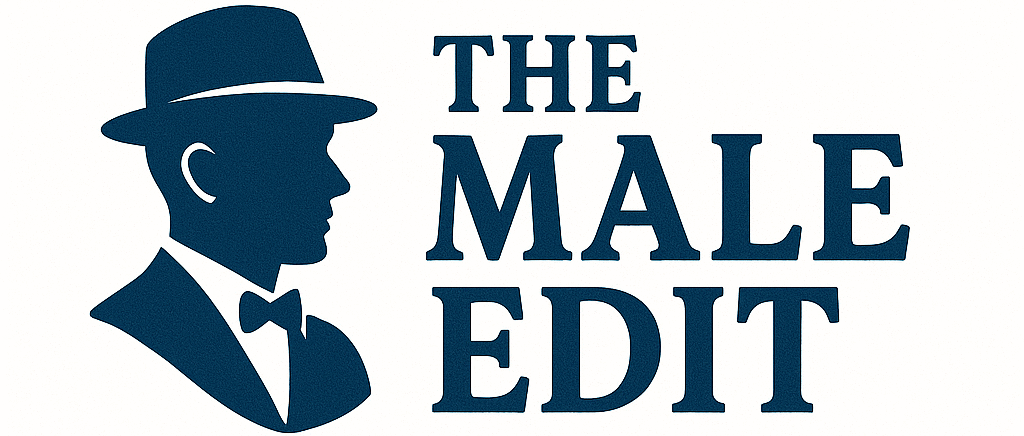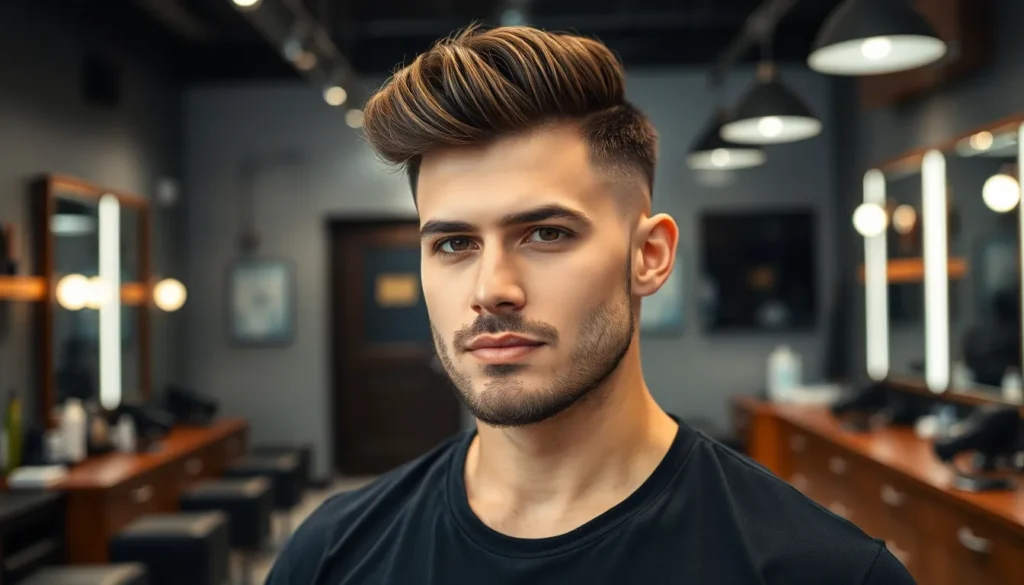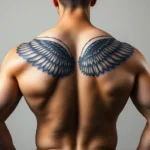Having thick hair as a man comes with its own unique set of challenges and opportunities. While you’re blessed with voluminous locks that many envy, finding the right haircut that works with your hair’s natural density can feel overwhelming. We’ve all been there – walking into a barbershop unsure of what style will actually look good and be manageable day after day.
The good news? Thick hair is incredibly versatile and can support virtually any haircut style you desire. From classic cuts that enhance your hair’s natural volume to modern styles that create sleek sophisticated looks, we’ll guide you through the best options available.
We understand that managing thick hair requires more than just a good cut – it’s about finding styles that complement your face shape, lifestyle, and personal aesthetic. Whether you’re looking for low-maintenance options or statement-making styles, we’ve researched the most effective cuts that’ll transform your thick hair from a daily struggle into your greatest asset.
Classic Crew Cut for Thick Hair Management
The classic crew cut stands as one of the most reliable haircuts for men with thick hair. We’ve found this timeless style effectively manages dense hair while maintaining a sharp, polished appearance.
Traditional Short Length Benefits
Short length transforms thick hair from overwhelming volume into controlled sophistication. We recommend keeping the top section between 1 to 2 inches to prevent excessive bulk while maintaining enough length for styling flexibility. The crew cut’s tapered sides eliminate the mushroom effect that plagues many thick-haired men with longer styles.
Weight distribution becomes significantly more manageable with this shortened length. Your thick hair naturally wants to expand outward, but the crew cut directs that volume upward and forward instead. This redirection creates the ideal proportions that complement most face shapes without requiring extensive styling products or techniques.
Temperature regulation improves dramatically with reduced hair length around the ears and neck. We’ve observed that men with thick hair often struggle with overheating, and the crew cut’s shorter perimeter provides much-needed ventilation while keeping the crown area substantial enough for style variation.
Easy Maintenance Requirements
Daily styling takes less than five minutes with a classic crew cut. We suggest using a small amount of lightweight pomade or styling cream to enhance texture without weighing down your thick hair. The natural density provides enough body that minimal product achieves maximum impact.
Washing frequency can be reduced to every other day since shorter hair doesn’t trap as much oil and debris. Your thick hair’s natural oils distribute more evenly across the reduced surface area, maintaining healthy moisture levels without appearing greasy. This reduction in washing also preserves your hair’s natural protective barriers.
Trimming schedules become predictable with crew cuts requiring touch-ups every 3 to 4 weeks. We recommend focusing these appointments on maintaining the side taper and keeping the top length consistent. The structured nature of this cut means growth patterns remain controlled and professional-looking between visits.
Professional Appearance Advantages
Corporate environments favor the crew cut’s clean lines and conservative appeal. We’ve noticed that thick hair in this style projects confidence and attention to detail, qualities highly valued in professional settings. The cut’s versatility allows for subtle styling adjustments based on your workplace culture and personal preferences.
Client-facing roles benefit from the crew cut’s universal appeal and trustworthy appearance. Your thick hair’s natural volume adds presence without appearing trendy or distracting. This balance helps establish credibility while maintaining an approachable demeanor that clients and colleagues appreciate.
Age appropriateness spans decades with the classic crew cut remaining suitable from your twenties through retirement. We find that thick hair tends to thin with age, making the crew cut’s shorter length adaptable as your hair density changes over time. The style’s timeless nature ensures you’ll never appear outdated or inappropriately youthful for your professional position.
Textured Crop Cut for Modern Style

Moving beyond traditional cuts, the textured crop offers a contemporary approach that maximizes thick hair’s natural advantages while creating a fresh, modern aesthetic.
Layered Cutting Technique
Point cutting transforms dense hair into a manageable, stylish crop by strategically removing bulk while adding movement. Professional stylists use this technique to create uneven ends that naturally separate and enhance texture. Razor cutting complements point cutting by softening harsh lines and creating seamless transitions between layers.
We recommend combining scissor over comb and clipper over comb methods for precision layering. These techniques allow barbers to create gradual length variations that prevent the blocky appearance common with thick hair cuts. Strategic layering reduces weight at the crown while maintaining enough length for styling versatility.
Styling Product Recommendations
Medium hold texturizing cream provides the ideal balance for textured crops on thick hair. This product type adds definition without creating heaviness that can flatten your natural texture. Apply a small amount to damp hair and work through evenly for optimal results.
Curl enhancers become essential for men with curly or wavy thick hair seeking to define their natural pattern. These products control frizz while maintaining the crop’s structured appearance. Choose alcohol-free formulas to prevent dryness that can make thick hair appear dull.
Versatile Styling Options
Wavy styles benefit from mid or low fades combined with choppy cutting techniques that emphasize natural wave patterns. This combination creates visual interest while managing bulk effectively. Use your fingers to scrunch damp hair with texturizing products for enhanced wave definition.
Straight styles require medium hold products applied to towel-dried hair before blow drying. Piece out sections with your fingers while the product sets to create separation and movement. This approach prevents thick straight hair from appearing too uniform or heavy.
Diffuser attachments revolutionize styling for curly thick hair by distributing airflow evenly and reducing frizz. Set your blow dryer to low heat and medium speed while gently cupping curls in the diffuser bowl. This technique enhances natural curl patterns while maintaining the crop’s clean lines.
Pompadour Haircut for Thick Hair Volume
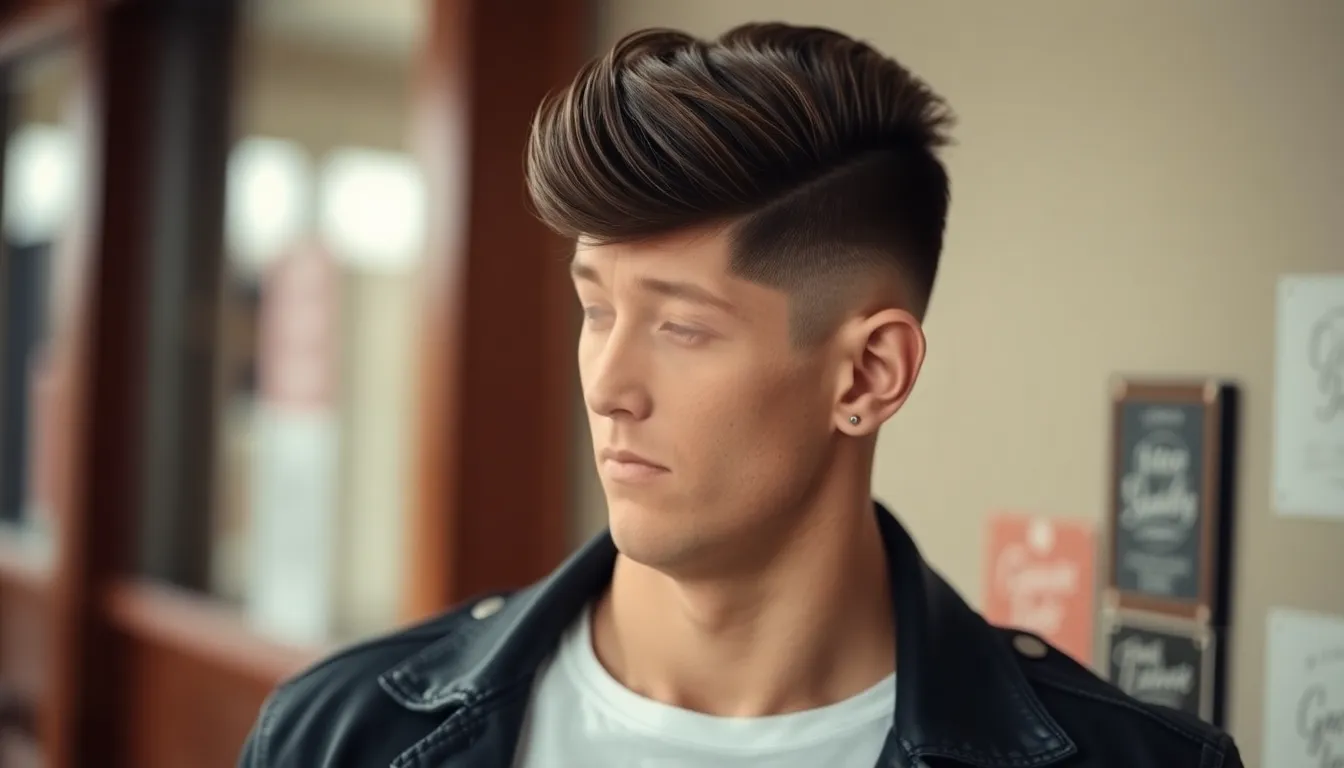
We’ve found the pompadour to be an exceptional choice for men with thick hair, as it transforms natural volume into a striking vintage statement. This classic style involves combing the top section upward and back while keeping sides slicked or faded, creating the perfect foundation for thick hair’s natural density.
Vintage-Inspired Sophistication
Hollywood icons like Elvis Presley and Brad Pitt have cemented the pompadour’s reputation as a timeless style that exudes glamour and refinement. We appreciate how this cut bridges formal and casual settings, making it incredibly versatile for modern men. The pompadour’s vintage appeal adds instant sophistication to any look, whether you’re attending a business meeting or weekend social event. Classic elements of this style create an elevated appearance that never goes out of fashion, giving thick hair the perfect showcase for its natural texture and volume.
Side Part Variations
Modern interpretations of the pompadour allow us to incorporate side parts for contemporary appeal while maintaining the style’s classic foundation. We recommend the side part pompadour as an excellent variation that adds asymmetrical interest to the traditional upward sweep. Sharp side parts create clean lines that complement the pompadour’s volume, offering a fresh take on the vintage original. These variations work particularly well with thick hair because the natural density supports both the side part definition and the pompadour’s signature height.
Daily Styling Routine
Our recommended styling approach starts with applying hair gel or pomade to damp hair, working the product upward and back to create the pompadour’s signature lift. We suggest using a small amount of hair wax or cream to add texture and make thick hair more manageable throughout the day. Essential tools include a quality comb or brush to maintain volume at the top while ensuring clean lines along the sides. Daily maintenance requires just a few minutes of styling time, making this sophisticated look surprisingly practical for busy schedules.
Undercut Styles for Thick Hair Control
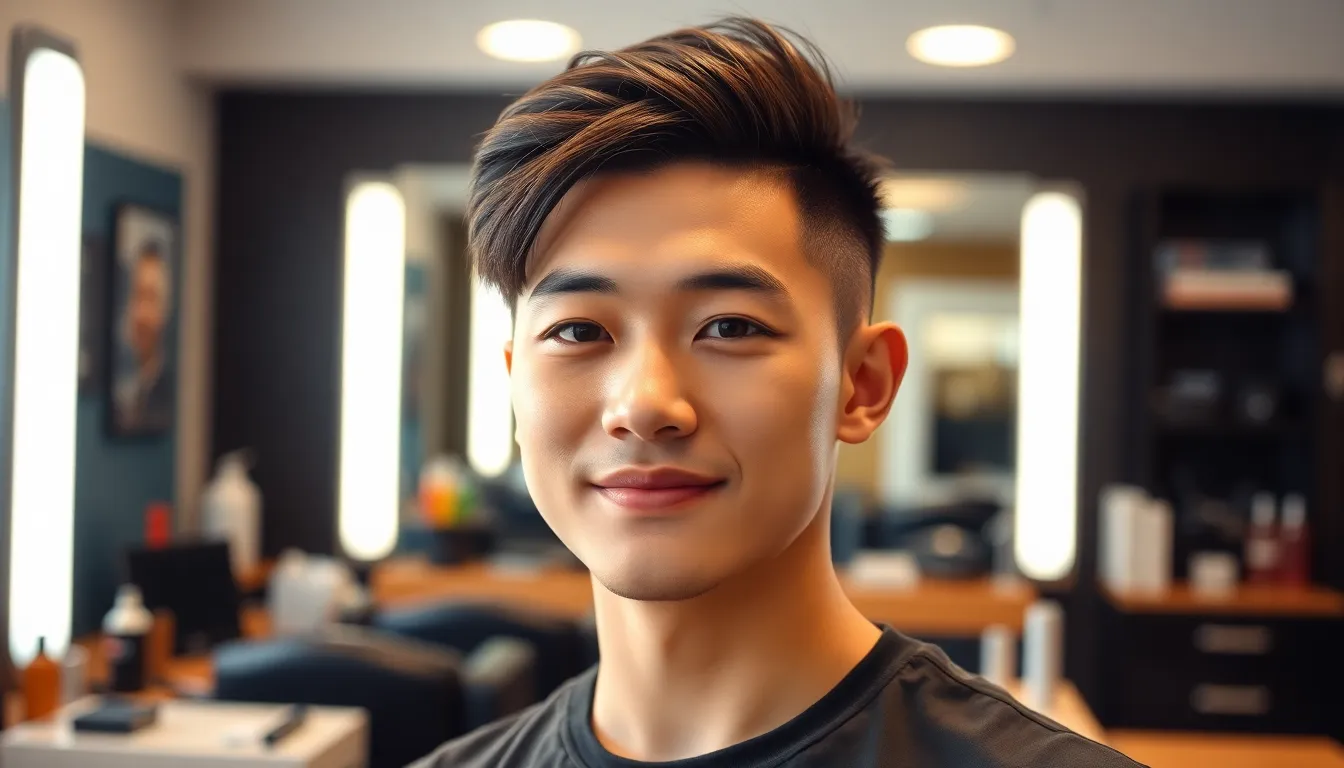
Undercut hairstyles excel at managing thick hair by creating dramatic contrast between longer top sections and shorter sides. We’ve found these styles particularly effective because they remove bulk from the sides while showcasing your hair’s natural density on top.
Disconnected Undercut Benefits
Disconnected undercuts create bold visual impact by maintaining stark contrast between long top sections and shaved sides without gradual transitions. This sharp division works exceptionally well for thick hair because it highlights natural volume while keeping sides completely manageable.
Modern styling becomes effortless with disconnected cuts since the dramatic contrast requires minimal blending or maintenance. We recommend this approach for men seeking edgy, contemporary looks that make strong style statements.
Weight reduction happens instantly when barbers remove hair from the sides, making thick top sections easier to style and control. Your natural hair density becomes an asset rather than a styling challenge with this strategic approach.
Fade Transition Options
Fade transitions offer smoother visual flow compared to disconnected cuts, creating gradual gradients from longer tops to shorter sides and backs. These blended approaches work particularly well for professional environments or conservative style preferences.
Low fades maintain maximum thickness on top while providing subtle tapering that doesn’t sacrifice volume. We’ve observed that low fades complement thick hair textures by preserving natural density while adding clean finishing touches.
High fades create dramatic contrast similar to disconnected cuts but with softer transitions that appear less stark. Taper fades specifically work well with thick hair because they balance heavy top sections with controlled side lengths.
Gradient customization allows personal expression through various fade heights and blending techniques. Your barber can adjust fade positioning based on your face shape and thickness levels for optimal results.
Top Length Variations
Short textured tops reduce bulk significantly while adding dimensional movement through layered cutting techniques. We suggest using texturizing products to separate layers and create definition that showcases your hair’s natural thickness.
Medium length tops accommodate versatile styling including curtain bangs and messy wave patterns that work especially well for longer face shapes. This length provides enough weight to control thick hair while offering styling flexibility.
Long top sections embrace natural texture fully, whether you have waves, curls, or straight thick hair. These lengths work beautifully with both disconnected and faded sides, creating striking visual contrast.
Quiff styles maximize volume potential by directing thick hair upward and back, creating height that transforms natural density into stylish elevation. Your thick hair texture provides the perfect foundation for achieving substantial quiff volume without additional products.
Quiff Hairstyle for Thick Hair Texture

The quiff represents one of the most sophisticated haircut choices for men with thick hair, transforming natural volume into a statement style. We’ve found this versatile cut perfectly balances classic elegance with modern styling techniques.
British-Inspired Elegance
Classic British charm defines the quiff’s timeless appeal, drawing from vintage hairstyles that have captivated men for decades. We appreciate how this style creates an elegant yet bold look by featuring short sides and back with longer hair on top. Modern styling products and techniques now cater specifically to thick hair’s natural fullness, making the quiff more accessible than ever.
Contemporary variations maintain the style’s sophisticated foundation while adapting to today’s grooming standards. We recommend the quiff for men seeking a distinguished appearance that works equally well in professional and social settings. This British-inspired cut carries an air of refinement that elevates any wardrobe choice.
Height and Volume Techniques
Strategic styling techniques maximize the quiff’s dramatic height and volume potential for thick hair textures. We suggest blow-drying hair upward before applying any product to create important lift and foundation volume. Starting with damp hair, use your hairdryer to raise the bangs while directing airflow upward and back.
Product application requires precision to achieve the signature quiff shape. We apply a small amount of pomade, clay, or wax starting from the bangs and top section, running our fingers sideways while pinching for rough unified volume. Fades or tapered sides enhance the contrast and make the top volume more pronounced.
Finishing techniques lock the style in place throughout the day. We complete the look with hair spray to maintain height and prevent the quiff from falling flat. This combination of blow-drying, strategic product placement, and setting spray creates the quiff’s characteristic bold silhouette.
Maintenance Tips
Regular trimming schedules keep the quiff’s shape sharp and prevent excessive weight buildup on top. We recommend visiting your barber every 3-4 weeks to maintain the precise contrast between the longer top section and shorter sides. This consistent maintenance prevents the style from losing its defined structure.
Daily care routines support thick hair’s health and manageability within the quiff style. We use moisturizing haircare products to keep thick hair healthy while avoiding blow-drying excessively, as this may cause unwanted frizz. Air drying with styling product often reduces frizz better than excessive heat application.
Gentle drying methods preserve the hair’s natural texture and prevent damage. We recommend using cotton t-shirts or pillowcases to dry hair gently and minimize frizz formation. These fabric choices create less friction than traditional towels, helping maintain the quiff’s smooth finish and natural volume.
Buzz Cut Variations for Low Maintenance

Buzz cuts deliver the ultimate practical solution for men with thick hair, eliminating daily styling routines while maximizing natural texture. We’ve found that thick hair responds exceptionally well to buzzed lengths, whether you choose uniform cuts or contemporary layered fades on the sides.
Different Guard Length Options
Guard selections determine your overall length and styling versatility across multiple clipper settings. We recommend understanding each option to achieve your desired look and maintenance level.
| Guard Number | Length | Appearance | Maintenance Level |
|---|---|---|---|
| #1 | 1/8 inch | Very short, closest to scalp | Minimal |
| #2 | 1/4 inch | Slightly longer, visible texture | Low |
| #3 | 3/8 inch | Noticeable length, softer look | Low to Medium |
| #4+ | 1/2 inch and above | Retains volume, limited styling | Medium |
Guards #1 to #3 create close crops that practically eliminate styling time while showcasing your hair’s natural density. Guards #4 and above leave more length for subtle texture variations and begin resembling crew cut territories with increased styling possibilities.
Scalp Health Benefits
Buzz cuts improve scalp health through multiple mechanisms that particularly benefit thick hair types. We’ve observed important improvements in overall scalp condition when men transition to shorter lengths.
Reduced sweat and oil buildup occurs naturally as shorter hair allows superior air circulation and easier cleansing routines. Minimized dandruff and irritation results from eliminating the oil and flake trapping that thick hair typically causes at longer lengths.
Direct application of treatments becomes significantly easier, allowing scalp treatments and medicated shampoos to absorb more effectively. This accessibility proves especially valuable for men dealing with scalp conditions that thick hair often complicates.
Growing Out Process
Growing out a buzz cut with thick hair requires strategic management to prevent unwanted bulk and maintain professional appearance. We recommend following exact techniques to navigate this transition successfully.
Regular trims maintain shape and prevent the bushy appearance that thick hair naturally creates during growth phases. Lightweight products like clays or pastes assist in taming emerging volume without weighing down new growth.
Transitioning through styles allows you to move from buzz cuts to textured crops or crew cuts as hair lengthens. Thinning shears become valuable tools for volume control during these intermediate stages.
Adjusting shampoo routines becomes essential as hair thickness increases, requiring lighter formulas to manage the additional density that accompanies length growth.
Side Part Haircuts for Thick Hair

Side part haircuts offer the perfect solution for organizing thick hair into a polished, masculine style that works seamlessly in professional and casual environments. We’ve found this classic approach creates distinct sections that manage volume while maintaining sophisticated appeal.
Classic Business Style
Precision defines the classic side part, with sharp parting lines created using a fine-tooth comb and enhanced with clipper work for contemporary appeal. We recommend maintaining extra length on top (more than 2 inches) to effectively control thick hair’s natural volume while preserving a neat appearance.
Short faded sides and back create structure that emphasizes professionalism and eliminates bulk around the ears and neckline. Our styling approach focuses on using pomade or gel products to achieve a sleek, lasting finish that withstands daily activities.
Volume management becomes effortless when barbers leave adequate length on top, preventing the spiky, unmanageable texture that occurs with overly short cuts. Business environments benefit from this style’s clean lines and polished presentation that projects confidence and attention to detail.
Modern Interpretations
Tapered sides replace traditional length in contemporary versions, creating smoother transitions that complement thick hair’s natural density. We’ve observed how undercut variations add dramatic contrast while maintaining the side part’s classic foundation.
Hard parts introduce bold definition through precisely shaved lines that separate sections with surgical accuracy. Modern styling techniques allow longer top sections to showcase texture through combed back looks, side-swept arrangements, or naturally loose finishes.
Matte products revolutionize the finish, with pastes and clays providing hold and texture without obvious shine or stiffness. We prefer these contemporary formulations because they create natural movement while maintaining structure throughout the day.
Textured styling options expand versatility, allowing thick hair to embrace its natural body rather than fighting against it. Contemporary interpretations balance classic elegance with relaxed, approachable styling that suits various lifestyle demands.
Parting Technique Tips
Natural growth patterns guide optimal placement, making styling easier and results more sustainable over time. We always assess hair’s natural direction before establishing the parting line to ensure lasting hold and effortless maintenance.
Top length preservation prevents management issues that arise when thick hair gets cut too short and becomes difficult to control. Maintaining adequate length provides styling flexibility while preventing unwanted spiky textures.
Sharp parting lines require exact tools, with fine-tooth combs creating the most precise divisions when combined with quality styling products. We recommend defining the part immediately after washing while hair remains damp and receptive to shaping.
Fade integration enhances modern appeal by creating graduated length transitions that complement the side part’s structured appearance. Professional execution ensures smooth blending between different lengths without harsh lines or uneven sections.
Hard part maintenance demands regular upkeep, requiring touchups every 2-3 weeks to maintain the shaved line’s crispness and definition. We suggest discussing maintenance schedules with your barber to keep this bold accent looking sharp and intentional.
Slicked Back Styles for Thick Hair

Slicked back hairstyles transform thick hair’s natural volume into sophisticated, structured looks that work exceptionally well for men seeking polished styling options. These versatile styles leverage your hair’s density to create everything from classic pompadours to modern quiff variations.
Formal Occasion Suitability
Slicked back styles with thick hair deliver unmatched versatility for formal events, offering the refined appearance that complements suits and formal wear perfectly. Your thick hair’s natural fullness creates the ideal foundation for weddings, business meetings, and other important occasions where a well-groomed yet ever-changing look makes the strongest impression.
Pompadour and classic quiff styles provide the perfect balance of volume and control, ensuring you maintain a professional appearance throughout lengthy formal events. These styles project confidence while remaining appropriately conservative for corporate environments and special celebrations.
Product Selection Guide
Choosing the right products for your thick hair slicked back style depends on your desired finish and hold strength requirements. We recommend these essential products based on your styling goals:
| Product Type | Hold Strength | Finish | Best For |
|---|---|---|---|
| Pomade | Medium to Strong | Shiny | Smooth, classic slick looks |
| Clay | Strong | Matte | Textured volume without shine |
| Wax | Flexible | Some Shine | Restyling throughout the day |
| Volumizing Mousse | Light | Natural | Pre-styling volume and lift |
| Hairspray | Strong | Variable | Final hold for all-day wear |
Pomades work exceptionally well for formal slicked back styles, offering medium hold with the polished shine that enhances your professional appearance. Clay products provide strong hold with a matte finish when you prefer textured volume without reflective shine.
Styling creams with medium hold serve as excellent alternatives for achieving the refined look formal occasions demand while maintaining natural movement throughout the day.
Application Methods
Starting with clean, towel-dried hair ensures your slicked back style achieves maximum hold and professional appearance. Follow these proven steps for optimal results:
Preparation stage begins with applying volumizing mousse or pre-styler to damp hair, creating the foundation for volume and directional control.
Blow-drying technique involves directing your thick hair backward using medium heat, establishing the slicked back direction while adding lift and body to your natural texture.
Product application requires warming a small amount of pomade, wax, or clay between your palms before distribution, ensuring even coverage without creating heavy buildup.
Styling process starts at your hairline, running your hands or a fine-tooth comb through your hair from front to back, focusing on your bangs and the volume-rich top section.
Finishing touches include light hairspray application to lock your style in place, particularly important for formal events requiring all-day hold and professional appearance.
This systematic approach maintains your thick hair’s natural volume while creating the structured, polished look that slicked back styles demand for formal occasions.
Layered Cuts for Thick Hair Thinning
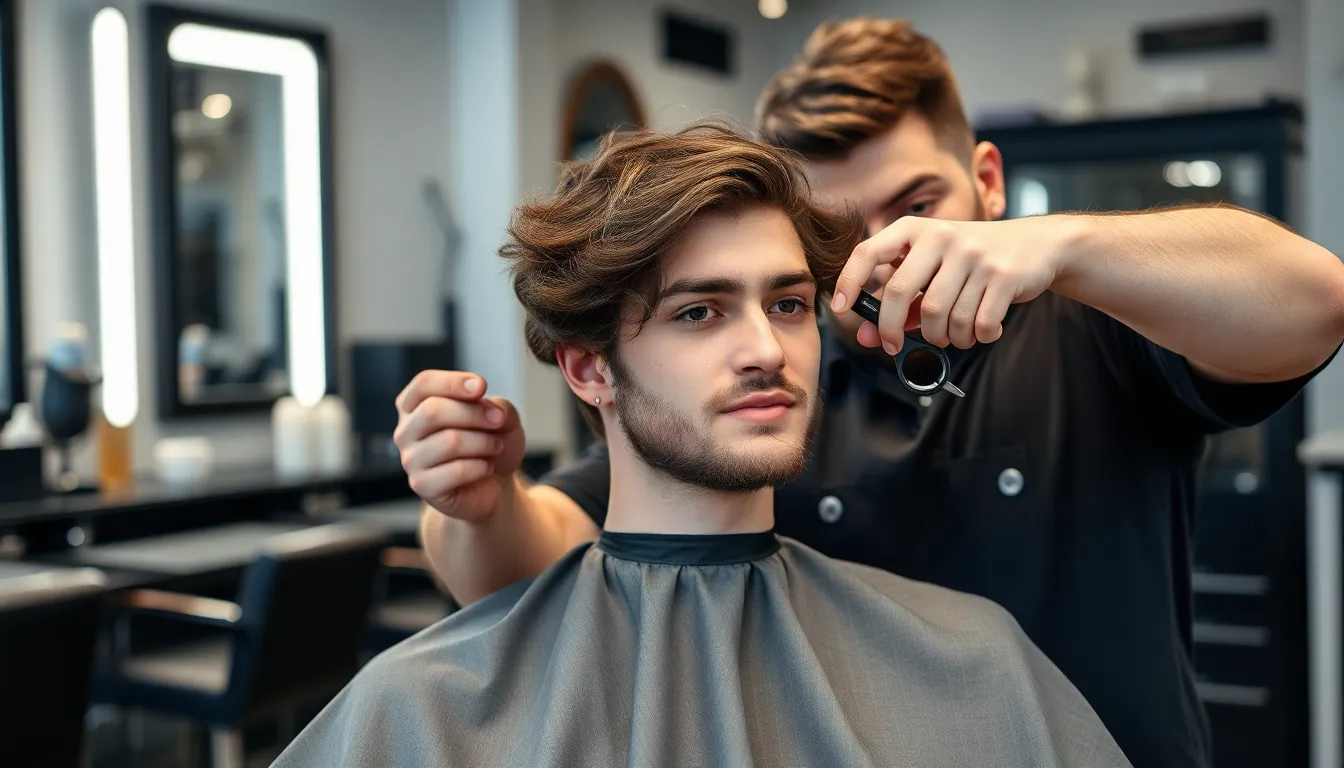
Layered cuts serve as the foundation for managing thick men’s hair by strategically removing bulk while preserving length. We use this core technique to create movement and prevent the heavy, blocky appearance that often plagues dense hair.
Weight Reduction Techniques
Thinning shears represent our primary tool for reducing hair weight while maintaining the overall style structure. Professional stylists rely on these specialized scissors to remove bulk without creating harsh lines or uneven textures.
Point cutting with regular scissors creates natural texture by softening hair ends and breaking up solid sections. We carry out this technique to add movement and reduce the blunt finish that can make thick hair appear even denser.
Razor cutting delivers sharp definition while further reducing thickness, particularly effective for men with wavy or curly hair patterns. Slicing with razors creates graduated layers that enhance natural hair movement and eliminate excess weight.
Clipper over comb and scissor over comb techniques provide standard methods for blending and controlling large hair volumes on the sides and back. These approaches ensure smooth transitions between different hair lengths while maintaining professional precision.
Texturizing Benefits
Breaking up solid hair sections through texturizing allows air to flow through the hair, dramatically improving manageability. We achieve this by using scissors or razors to create strategic cuts that reduce density without sacrificing style integrity.
Enhanced natural movement results from texturizing techniques that highlight wavy or curly patterns in thick hair. This process transforms previously unruly hair into styled, controlled sections that move naturally with daily activities.
Split end reduction occurs as a secondary benefit of point cut finishes, which help maintain overall hair health. We prioritize these techniques because they add a modern, edgy appearance while supporting long term hair condition.
Styling becomes significantly easier when thick hair receives proper texturizing treatment. Reduced bulk means less resistance when applying products and less time spent fighting natural volume during daily grooming routines.
Styling Flexibility
Product versatility expands dramatically with properly textured thick hair, allowing effective use of pomades, creams, or clays for various styling goals. We can shape and hold hair in place using different products based on desired finish and hold strength.
Blowout techniques work exceptionally well with thick, wavy hair when combined with diffuser drying to amplify natural curls and create controlled volume. This approach maximizes the hair’s natural texture while maintaining professional appearance standards.
Texturizing creams provide definition and separation for men with straight thick hair, creating distinct hair segments that enhance overall style structure. We apply these products to achieve separation without weighing down the hair or creating greasy buildup.
Trend compatibility improves with textured cuts that accommodate both classic and contemporary styling approaches. This flexibility ensures hairstyles remain current while working with the hair’s natural characteristics rather than fighting against them.
Conclusion
Having thick hair as a man opens up incredible styling possibilities that many can only dream of. We’ve explored how the right haircut can transform what might feel like a challenge into your greatest asset.
Whether you’re drawn to the timeless appeal of a crew cut or the bold statement of a pompadour the key lies in choosing a style that works with your hair’s natural density rather than against it. Remember that professional consultation can make all the difference in achieving the perfect cut for your face shape and lifestyle.
With the right approach thick hair becomes a powerful tool for expressing your personal style. Embrace your natural volume and let it work for you – the results will speak for themselves.
Frequently Asked Questions
What are the best haircuts for men with thick hair?
The best haircuts for thick hair include crew cuts, textured crops, pompadours, undercuts, quiffs, and buzz cuts. These styles work with your hair’s natural density rather than against it. Classic crew cuts offer professional polish, while textured crops maximize natural advantages. Pompadours transform volume into vintage statements, and undercuts create dramatic contrast between longer tops and shorter sides.
How do I style thick hair without it looking bulky?
Use layered cutting techniques and texturizing methods to reduce bulk while preserving length. Apply medium-hold texturizing cream or matte products for natural finishes. Blow-dry strategically for lift, and consider thinning shears or point cutting to create movement. Regular trims help maintain structure and prevent the mushroom effect common with thick hair.
What products work best for thick hair styling?
Effective products include pomade for slicked-back styles, clay and wax for hold and texture, volumizing mousse for lift, and medium-hold texturizing cream for natural movement. Choose products based on desired finish – matte products for casual looks, pomade for formal styles. Start with clean, towel-dried hair and apply products systematically for best results.
How often should I trim thick hair?
Thick hair requires regular trims every 4-6 weeks to maintain shape and prevent bulk buildup. This frequency helps preserve your chosen style’s structure, whether it’s a crew cut, quiff, or textured crop. Regular maintenance prevents the heavy appearance that thick hair can develop and keeps your style looking fresh and intentional.
Are buzz cuts good for thick hair?
Yes, buzz cuts are excellent for thick hair as they maximize natural texture while eliminating daily styling routines. Different clipper guard lengths offer various maintenance levels – shorter cuts require less upkeep. Buzz cuts improve scalp health by reducing sweat and oil buildup, making it easier to apply treatments and maintain scalp conditions effectively.
How do I manage thick hair during the growing-out process?
During the growing-out phase, schedule regular trims to maintain shape and use lightweight products to control increasing volume. Adjust your shampoo routine to accommodate the hair’s increased density. Consider transitional cuts like textured crops or layered styles that work with your hair’s natural thickness while maintaining a polished appearance throughout the growth process.
What’s the difference between pompadours and quiffs for thick hair?
Pompadours sweep hair back and up, creating vintage elegance ideal for formal settings, while quiffs feature short sides with longer, forward-styled tops for British-inspired charm. Both styles work excellently with thick hair’s natural volume. Pompadours offer more dramatic height, while quiffs provide versatile styling suitable for both professional and casual environments with sophisticated balance.
